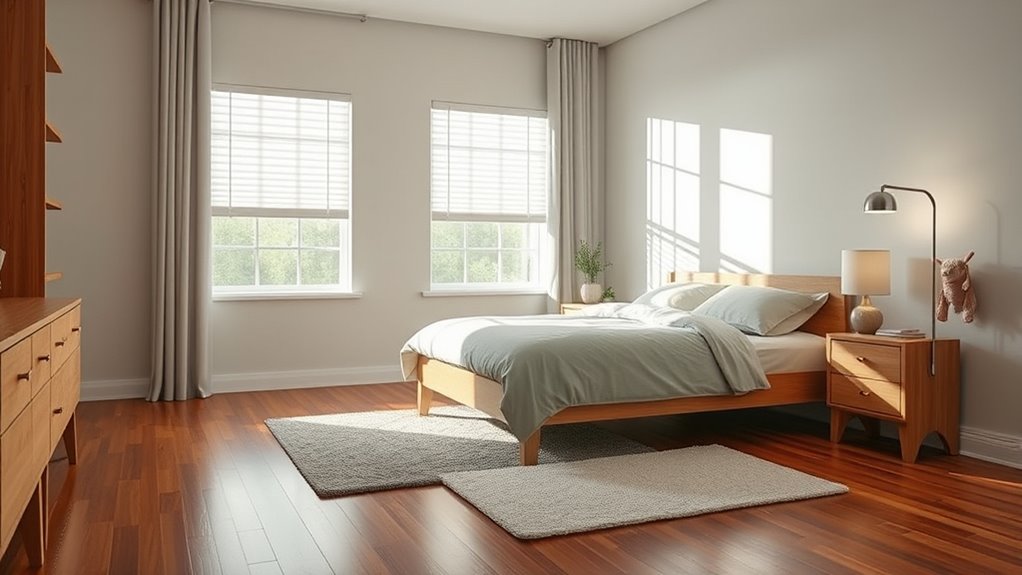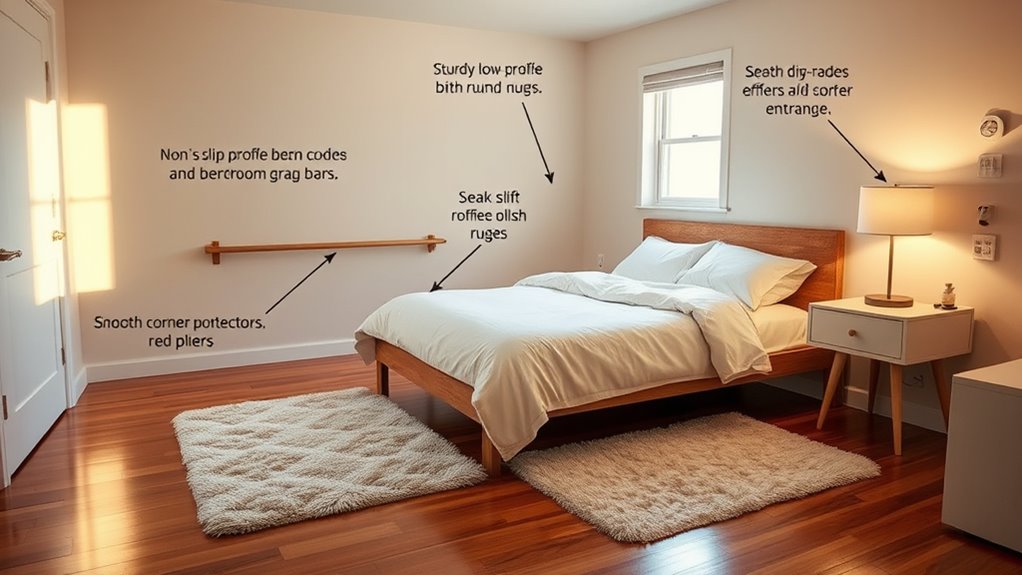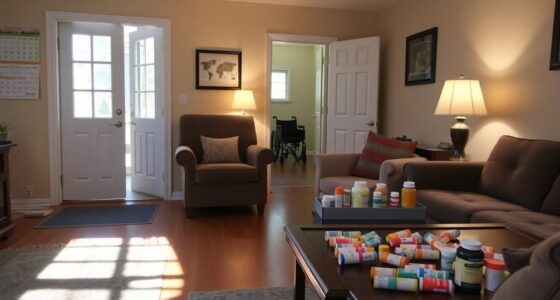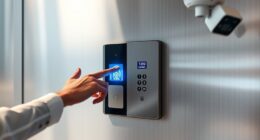To keep your bedroom safe and provide peace of mind, guarantee escape routes are always clear and accessible, and install easy-to-operate windows or backup escape options like safety ladders. Improve lighting with energy-efficient bulbs and motion sensors, and keep pathways free from clutter and hazards. Regularly test smoke detectors and make sure doors and windows work smoothly. For more tips on creating a secure space you can trust, continue exploring effective safety modifications.
Key Takeaways
- Ensure clear, unobstructed escape routes with accessible windows and safety ladders for quick evacuation.
- Install bright, energy-efficient lighting with switches positioned conveniently for safe nighttime navigation.
- Keep pathways clutter-free and secure loose rugs or heavy items to prevent trips and falls.
- Equip the room with functional smoke detectors and maintain easy-to-operate windows and locks.
- Regularly practice emergency escape drills to build confidence and ensure preparedness during crises.

Creating a safe bedroom environment is essential for preventing accidents and guaranteeing peace of mind. One of the most important aspects of safety is making sure you can escape quickly in case of an emergency. An emergency escape plan should be clear and accessible, with a designated route that you can follow easily. If your bedroom is on the second floor or higher, consider installing a sturdy, easily accessible window that can serve as a backup escape point. Keep windows unobstructed and ensure they open smoothly, so you can exit swiftly if needed. Additionally, keeping a safety ladder nearby can be a lifesaver during emergencies, especially if children or elderly family members are involved. Regularly practicing your escape route helps you feel confident and prepared, reducing panic during actual emergencies.
Lighting improvements are another vital element when creating a safe bedroom. Proper lighting not only enhances the room’s ambiance but also prevents accidents caused by poor visibility. Switch to bright, energy-efficient bulbs that illuminate every corner of your bedroom, including under the bed and along pathways. Installing night lights or motion-sensor lighting can be particularly helpful during nighttime. These lights provide enough illumination to navigate safely without disturbing your sleep. Make sure switches are easily accessible from the bed, ideally at the entrance and near the bathroom or closet area. Consider adding additional lighting fixtures if your room is large or has dark corners. Well-lit rooms reduce the risk of trips and falls, especially for those who may wake up disoriented or have limited mobility. Incorporating lighting improvements based on the room layout can further enhance safety and visibility.
Beyond lighting, guarantee that pathways are clear of clutter, cords, or furniture that could pose tripping hazards. Secure loose rugs and avoid placing heavy items on high shelves where they could fall. Use outlet covers and secure cords to avoid accidental trips or electrical hazards. When thinking about emergency escape, also remember to keep your bedroom door unlocked or install a lock that can be easily opened from the inside to facilitate quick egress. Installing a smoke detector within the room and regularly testing it adds another layer of safety, alerting you promptly to potential fire hazards.
Frequently Asked Questions
How Often Should Safety Modifications Be Reassessed?
You should reassess safety modifications regularly to guarantee they remain effective. It’s recommended to follow a maintenance schedule, checking your modifications at least once a year. Assessment frequency depends on factors like changes in your health, home environment, or if you notice any issues. Regular reviews help catch potential hazards early, keeping your space safe and secure. Stay proactive by setting reminders for these assessments to maintain peace of mind.
Are There Budget-Friendly Options for Bedroom Safety Upgrades?
Did you know that many safety upgrades cost less than $50? When considering budget options, focus on safety priorities like secure rugs, grab bars, and good lighting. These simple changes can prevent falls and injuries without breaking the bank. You don’t need expensive equipment; small, affordable modifications make a big difference in creating a safer bedroom environment. Prioritize what matters most, and stay safe without overspending.
Can Safety Modifications Be Customized for Specific Disabilities?
Yes, safety modifications can be customized for your specific needs. You should explore personalized adaptations and disability-specific solutions to make your bedroom safer and more comfortable. By working with professionals, you can identify the best modifications, like grab bars or adjustable furniture, tailored to your disability. This personalized approach guarantees your space meets your unique requirements, giving you peace of mind and a safer environment tailored just for you.
What Legal Considerations Exist for Installing Safety Features?
Imagine your bedroom as a sanctuary, each safety feature a shield against potential hazards. When installing these modifications, you must consider legal aspects like liability concerns and safety standards. Ensuring your modifications meet local building codes and regulations helps protect you legally and guarantees safety. Always check with authorities or professionals to confirm compliance, so your space remains both secure and legally sound.
How Do I Involve Family Members in Safety Planning?
You should prioritize family involvement and safety communication when planning safety measures. Talk openly with your family members about potential hazards and listen to their concerns. Encourage everyone to share ideas and participate in safety decisions, making them feel valued and responsible. By involving your family, you create a supportive environment where safety becomes a shared goal, ensuring a safer, more secure home for everyone.
Conclusion
So, while you’ve added all these safety features to keep your bedroom secure, don’t forget that sometimes, the biggest safeguard is simply paying attention. Ironically, in trying to make your space completely foolproof, you might overlook the small, everyday habits that truly prevent accidents. Remember, safety isn’t just about gadgets and modifications — it’s about staying present and cautious, even in your most “safe” haven. After all, no upgrade can replace common sense.









